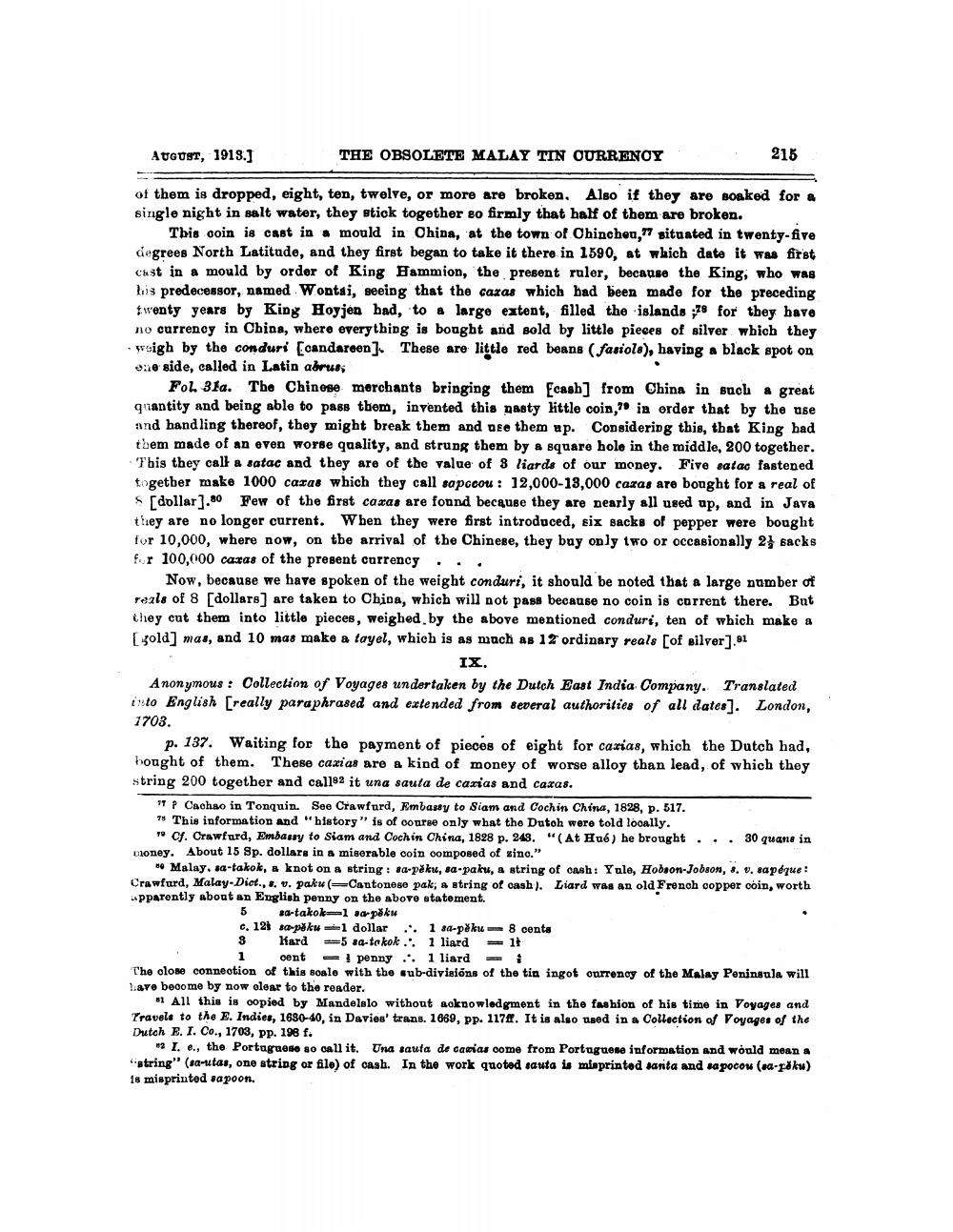________________
AUGUST, 1913.)
THE OBSOLETE MALAY TIN QURRENOY
215
of them is dropped, eight, ten, twelve, or more are broken. Also if they are soaked for a single night in salt water, they stick together so firmly that half of them are broken.
This coin is cast in . mould in China, at the town of Chinchen, situated in twenty-five degrees North Latitude, and they first began to take it there in 1590, at which date it was first cast in a mould by order of King Hammion, the present ruler, because the King, who was luis predecessor, named Wontai, seeing that the caras which had been made for the preceding I wenty years by King Hoyjen had, to a large extent, filled the islands ;78 for they have no currency in China, where everything is bought and sold by little pieces of silver which they • weigh by the conduri Coandareen). These are little red beans (faniolo), having a black spot on eze side, called in Latin abrus,
Fol. 31a. The Chinese morchants bringing them fcash] from China in such a great quantity and being able to pass them, invented this pasty little coin,' in order that by the use and handling thereof, they might break them and dee them ap. Considering this, that King had tbem made of an even worse quality, and strung them by a square hole in the middle, 200 together. This they call a satac and they are of the value of 8 liards of our money. Five satac fastened together make 1000 caras which they call sapocou : 12,000-13,000 casas are bought for a real of
[dollar).80 Few of the first casas are found because they are nearly all used up, and in Java they are no longer current. When they were first introduced, six sacks of pepper were bought for 10,000, where now, on the arrival of the Chinese, they buy only two or occasionally 2 backs for 100,000 caxas of the present currency.. .
Now, because we have spoken of the weight conduri, it should be noted that a large number of reals of 8 [dollars) are taken to China, which will not pass because no coin is current there. But they cut them into little pieces, weighed by the above mentioned conduri, ten of which make a old) mas, and 10 mas make a layel, which is as much as 12 ordinary reals [of silver].81
IX. Anonymous : Collection of Voyages undertaken by the Dutch East India Company. Translated into English [really paraphrased and extended from several authorities of all dates). London, 1703.
p. 137. Waiting for the payment of pieces of eight for caxias, which the Dutch had, hought of them. These caxi as are a kind of money of worse alloy than lead, of which they string 200 together and calle2 it una sauta de caxias and caxas.
TP Cachao in Tonquin. See Crawfurd, Embassy to Siam and Cochin China, 1828, p. 517. " This information and "bistory" is of course only what the Dutoh were told looally.
C. Crawfurd, Embassy to Siam and Cochin China, 1828 p. 243. "(At Hub) he brought ... 30 quane in coney. About 15 Sp. dollars in a miserable coin composed of sino."
* Malay, sa-takok, a knot on a string : Sa-pěku, sa-paku, a string of cash: Yule, Hodaon-Jobson, 8. v. sapeque: Crawfurd, Malay-Diet... v. paku(-Cantonese pak, a string of cash). Liard was an old French copper coin, worth pparently about an English penny on the above statement.
5 sa-takok-lapoku c. 121 sq-pöku -1 dollar .. 1 80-pěku 8 centa 3 Kard =5 -te kok .. 1 liard = it
1 cent penny .. 1 liard - i The olone connection of this soalo with the sub-divisions of the tin ingot onrrenoy of the Malay Peninsula will 1.ave become by now olear to the reader.
All this is copied by Mandelalo without acknowledgment in the fashion of his time in Voyages and Travels to the E. Indies, 1630-40, in Davies' trans. 1869, pp. 1178. It is also red in a Collection of Voyages of the Dutch E. I. Co., 1703, pp. 198 f.
12 I. e., the Portuguese so oall it. Una sauta de Caxias come from Portuguese information and would mean a atring" (na-utas, one string or file) of cash. In the work quoted sauta is miaprintod santa and sa pocow (na-poku) 18 misprinted rapoon.




